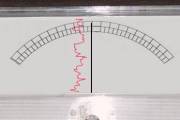What is an ARC Break? |
||||||||||||||||||||
An ARC break is in common language known as an
upset or a condition of being shocked, disappointed, surprised, etc. The
reason it is called an A-R-C break is, that it gives an inside look and
the anatomy of what is going on. By using the name A-R-C break we have
included some important data about the mechanism. In a dictionary,
including slang, you can probably find hundreds of terms used to describe
this. Omitting the slang we can here add, getting angry at somebody, blow
up, getting offended, saddened, etc., etc. In other words these are very
well known phenomena. We all know them from countless situations. We see
it happen to others and we get subject to it ourselves. the simple act of
defining it as A-R-C- breaks suddenly opens the door to do something about
it.
First, for an ARC break to happen there must have been some ARC in the first place. The more ARC there was the greater the ARC break can get. This is seen in divorce courts on a daily basis. The saying is, "Hell hath no fury like a woman scorned". A woman betrayed by her husband can raise hell on him. The woman wouldn't do this to a complete stranger. It was the tremendous ARC that was built up during their marriage that laid the groundwork for this. Without that prior ARC there wouldn't be an ARC break. Family feuds among siblings is another example of this - starting with Cain and Able. You could see the conflict of the Middle East as an ARC break. You have two populations, Arabs and Jews, in Israel. They both love the land. There was a break in Reality following World War Two when the British and the French cut out a new map for Arabia and, supported by UN, set up the Palestine Territory and later the State of Israel. For one thing, the British (and especially the British officer Lawrence of Arabia) had promised the Arabs the land after they in World War One defeated the Turkish who ruled the land. Endless confrontations and fights are now going on between the Jews and the Palestinians apparently with no end in sight. Diplomacy seems the method of choice in handling ARC breaks in a political scene and even in a social setting. But diplomacy, as being polite and underhanded, does nothing in terms of finding the correct BPC and indicate it. As a result the diplomats on a regular basis have to pull out and give room for an outright war. When it comes to this stage all kinds of out ruds are the order of the day; the basic problem over the land. The aggressive acts and acts of war: overts and withholds. But it was preceded by an upset: an ARC break in relation to Reality. Let's refresh quickly what we know about ARC: 'ARC = Understanding': Affinity, Reality and Communication are the component parts of Understanding. This is one of the most basic discoveries of R. Hubbard. It is simple, yet it affects all parts of life and livingness. Although statements of this undoubtedly can be found in all kinds of philosophies and religious writings, there has never existed such a clear statement of it that can be used directly in all human relationships; and if it goes wrong this fundamental datum can be used to repair the situation with. And here we are at the center of Level 3: how to repair ARC breaks! ARC itself was covered extensively at
Level 0. Why is it so central to what we are doing in ST? The answer
here is also simple. What we are engaged upon in ST is a freeing up of
theta and life force. We are seeking to restore the thetan to his full
capacity. And here is the point: "The three component parts of theta
are Affinity, Reality and Communication" - ARC. So just by you
being there, there is a presence of ARC. It has nothing to do with putting
on a big smile in the morning or feeling great. These things are of course
manifestations of ARC. But at the core it is always there no matter how
bad we feel because life itself is ARC. What all the scales of Level 0
show are measuring sticks of the amount of ARC present. Even at the very
bottom of these scales, ARC is present at a minimum level. The way pc's go
down these scales over time happens in bumps, in sudden small or big
drops; and that are the ARC breaks. On Level 3 we learn to undo these
pumps or drops in life and move the pc back up these scales by applying
the ARC break data of Level 3. So we have theta or ARC at the beginning and it may even build up over time - say in a friendship. Then suddenly something happens and we have an ARC break. Since we in auditing are trying to restore ARC both in relationships the pc has, but also as a quality of his very beingness, knowing what an ARC break is, is very useful. We also need to know what is happening on a practical level so we can repair it if it should turn up or happen in session. We know we have a thetan with a certain amount of
theta and suddenly it is lowered. A break in one of the component parts of
A, R and C has taken place. As a result all three are reduced as they are
really different sides of the same thing. That's why it is called the ARC triangle.
When one side is reduced, the other sides are as well. The size of the
whole triangle is reduced. There is this close relationship between the
parts. The communication formula: Cause, distance, effect with duplication
and understanding can be seen to have all the elements of ARC. The
affinity part is overcoming the distance and the reality part is the
amount of duplication taking place. It results in greater understanding
when successful. If not successful it results in lowered understanding.
The simple action of communicating causes thus an increase or decrease in
ARC.
Auditing a pc over an ARC break makes the pc worse.
ARC Breaks and Missed Withholds It does work well as first aid in O/W type of auditing, because it is the primary cause in this type of auditing. Also the pc is tuned in to what to look for. It works well on pc's who have a high responsibility level, because they are capable of looking at their troubles from the viewpoint of cause. The statement on Level 2 was: "If you pick up the missed withholds at the first sign, the pc will stay in-session"; "at the first sign" is key to be able to use only this tool. In other words it is valid, but does not always open the door to a handling. Today Missed Withholds are viewed as one type of BPC. In practice you would use the guidelines of Auditor's Rights to pick the tool to use to handle Out Ruds in session.
ARC Breaks and By-passed Charge
The connection to missed withholds is clear. A missed withhold is By-passed Charge, but the definition of BPC is more flexible and broader. We can expand a little on this: By-passed Charge comes about as a comm cycle that is started, but not wholly detected or understood. Charge is energy that is mobilized and meant to go in a certain direction. But it never arrives, because it is not wholly detected or understood. So it always remains as BPC, then explodes in a dispersal of some sort. It does not always explode. Sometimes it just results in a down-tone pc who is 'not feeling so well, lately'. By stating ARC breaks as caused by BPC there is no attempt to blame it on the pc as a withhold and no demand for the pc to 'take full responsibility for it'. Find the charge with a Meter and indicate the correct BPC is all it takes. This is a very workable approach as a first aid. This can be done on a pc who is already suffering from a severe ARC break. This approach thus has a real practical value. And the value and the techniques developed from this theory have proven to be extremely useful - way beyond being a simple first aid. Locating and indicating (or handle further) the correct BPC is today the tool for repairing any severe troubles pc's can run into. Repair Lists covering just about any possible situation have been developed based on this principle. These lists also cover M/W/H's.
Examples of generalities: "They say you are always late". "Everybody thinks this suggestion is stupid". "The will of the people". Using generalities is a well known method of people of ill will. Such people use it knowingly to ARC break others. Let's say, that a colleague tells you, "they say you are always late." In the past such a statement could make you feel real bad and insecure. No need for that anymore. First ask, "who said that?" You may get some arrogant answers but keeping at it and finding out who 'everybody' is and what he/she actually said, you will finally get it nailed down to: "Bettie, noticed you were five minutes late for work the other day". That is a lot easier to deal with and would not cause an ARC break. Knowing that, it would even be easy to go to Bettie and explain to her why you were late. Example: Little boy screaming and crying because he made a mistake in doing a drawing. You observe the boy is upset: "What are you upset about, Little Bill?" Little Bill: "My drawing is no good!" You: "Who said your drawing is no good?" Little Bill: (crying) "The teachers at school (plural)." You: "What teacher (singular)?" Little Bill: (sobbing) "Not the teachers, the other kids (plural)!" You: "Which one of the other kids?" Little Bill: (suddenly quiet) "Jimmy!" You: "How do you feel now?" Little Bill: (cheerfully) "Can I have some candy?" What you are using is this formula:
These steps work great; Meter or not. Next time somebody says, "The
teachers are mean," don't make the error to try to indicate the
charge with "OK, you are ARC Broken because the teachers are
mean." Instead you find out "What teacher is teachers?" If
you push it a bit you'll find it. You will probably find it wasn't "
the teachers" or even "a teacher" but somebody else
entirely. And that somebody else will be one individual, not a group. An interesting use of this is
"Who uses the word ‘everybody' frequently?" It's of interest
only because "everybody" makes a smoke screen (dispersal) which
the person can't see through. It can take quite a while sometimes for a
person to spot such an individual and the question should be used with
caution. The Not There is a special type of generality because it can be anywhere. But it is a special case. When something becomes impossible to locate it can cause an ARC Break. The cure for this situation is to find out what's gone. If you see somebody with a cold,
ask them, "Who is gone?". Losses and ARC breaks can cause a
cold, you know. You'll see a few recoveries if you get the question fully
answered.
ARC Break of Long Duration Session ARC Break A Session ARC break is defined as "the pc's
transfer of attention from the Bank to the auditor and a dramatization of
the Bank directed at the auditor." A session ARC break is different from a pc telling about an ARC break he had with somebody before session. Here the session or auditor is not at risk and it can be handled with using "Flying Ruds", often the auditor simply has to flatten the process that turned up the ARC break. There is an element of judgment here. The auditor has to determine if the in-session'ness of the pc is in jeopardy and if the process he is running turned it on and should be able to turn it off simply by being taken to EP.
ARC Break Needle The needle of an ARC break may also be dirty, stuck or sticky. The pc will be upset and out of comm at the same time. The best advice is thus to observe the pc first and the Meter second. Summary
|
||||||||||||||||||||


















